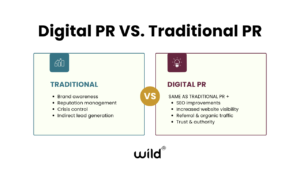It hasn’t always been referred to as ‘traditional PR’. Not too long ago, it was just PR – focusing on traditional mass-media, including print, television and even radio, to improve brand awareness and enhance visibility.
However, with the rapid growth in digital marketing, traditional PR isn’t what it used to be – because traditional media is no longer what it used to be.
Online use continues to grow rapidly
Did you know that annual figures show average daily minutes of desktop internet consumption per capita amounted to 39 minutes, with daily mobile internet consumption amounting to a whopping 155 minutes in 2021? This has increased by 12% since last year and means we spend 297% more time browsing the internet on our phone than on desktops in the UK.
As we spend so much time glued to our devices, we consume news and entertainment differently from how we did, say two years ago. This has led to brands making changes and adapting their strategies to ensure PR activity still lands with their target audience.
The media industry is evolving rapidly, so is PR.
Traditional PR vs Digital PR
Traditionally PR would comprise print, events, radio and television, and a considerable amount of time would be spent building journalist relationships, writing press releases, reputation management and attending trade shows.
Using traditional PR can significantly boost brand credibility, with this type of media being easily identifiable. For example, almost every manufacturer will know they can read ‘The Manufacturer’ for the latest insight and trends. In contrast, they may not necessarily know how to find a trustworthy blog on manufacturing.
One of the biggest challenges of traditional PR is that it’s harder to track the return on investment. You can’t conclusively tell how many people have read your article, or seen you at a trade show and have then gone on to make an enquiry or even a purchase.
Compare this to digital PR and you can track this success effectively via multiple techniques such as page views, SERP improvements, organic traffic, goal conversions and referrals.
In many ways, digital PR is similar to traditional, with both relying on building relationships and distributing content. However, the difference with digital is that communication with target audiences is made online and through social media.
Both methods cover crisis and reputation management and focus on building brand awareness, but how they approach them differs. Digital PR is basically an evolved form of conventional PR, using tried-and-tested strategies tailored to a digital world.

Whereas traditional PR uses offline media to gain brand coverage and increase brand awareness, digital PR uses online marketing strategies to boost brand presence and visibility. It’s no longer just about landing a double spread in a newspaper – it’s about improving Google SERP rankings, domain authority, organic referrals and the number of shares. Marketing departments now have specific teams looking into SEO and PPC with the goal of improving their online presence, so they shouldn’t forget to also upgrade their PR strategies to cover digital channels too.
As shared recently by my colleague, Frankie, digital PR and SEO go hand-in-hand. If you want to improve awareness and increase organic traffic to your business, improving your SERP through link-building is now a crucial factor in PR.
Although backlinks are essential, this doesn’t mean you’ll benefit from obtaining any old links. Search algorithms now look for high-quality, trusted publications and content when ranking keyword positioning and website rankings, meaning poor-quality links will have a detrimental effect.
Find a balance between digital and traditional
Although digital PR is becoming increasingly popular alongside the rapid growth in digital marketing, there is still a place for traditional PR strategies. Don’t try to decide whether to invest in one or the other, it’s best to use a combination.
The world may be growing more digital by the minute, but after a year refined to our homes, many of us can’t wait to get back out there networking and building relationships face-to-face.
Furthermore, we still get the majority of our news and entertainment from traditional media. In fact, according to annual figures, the average individual spent 182.95 minutes watching broadcast television in the United Kingdom, so it would be foolish to completely ignore what still works.
However, digital PR is growing at a rapid pace, enabling businesses to reach millions of potential customers at a cost-effective rate.
To conclude, we believe neither is superior to the other, if anything in the future we believe it will simply be referred to as “PR”. To achieve maximum exposure, businesses should execute a mixed method of techniques and find a balance that works best for the brand.
For more tips and tricks on PR, social media and marketing, head over to our Instagram, Twitter, Facebook and Linkedin or get in touch today for further insight.